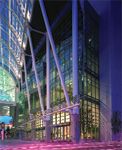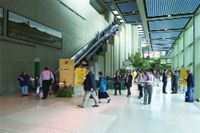The 54th Annual ASMS Conference: A Review
Spectroscopy editor Prachi Patel-Predd provides a wrap-up of the 54th ASMS Conference, held thi syear at the Washington State Convention and Trade Center in Seattle, Washington. Included are details of events, short courses, and all that was new and exciting at the show.

The 54th annual American Society for Mass Spectrometry Conference on Mass Spectrometry and Allied Topics was held from May 28 to June 1 at the Washington State Convention and Trade Center in Seattle, Washington.
The conference is an important and exciting event for those involved in mass spectrometry—a fact that was made apparent by the large number of people who attended and the increase in the number of presentations this year. More than 6000 scientists were at the conference, and about 3000 papers were presented as posters and talks.

Barbara Larsen, ASMS vice president for programs and member of Spectroscopy's editorial advisory board, had predicted the increase in attendance. In an ASMS conference preview that Spectroscopy presented in a May supplement on mass spectrometry, Larsen had speculated that the attendance would go up because compared to last year, the conference had seen a ten percent increase in the number of technical abstracts that were submitted.
Plenary Lectures
Each conference day except the last opened with a plenary lecture followed by seven parallel oral sessions and two periods of formal poster presentations. Lisa Randall, a Harvard University (Cambridge, Massachusetts) physicist, presented the initial plenary lecture on Monday, the first day of the conference. Randall, said to be today's most cited theoretical physicist, is the author of Warped Passages: Unravelling the Mysteries of the Universe's Hidden Dimensions, a book on the hidden dimensions of the universe, which was released in September 2005. Her talk had the same title as her book.
Randall received the Ph.D. degree in particle physics from Harvard in 1987. She has held fellowships at the University of California, Berkeley and Lawrence Berkeley National Laboratory (Berkeley, California), and professorships at Massachusetts Institute of Technology (Cambridge, Massachusetts), and Princeton University (Princeton, New Jersey), before she became a professor of physics at Harvard.
On June 1, which was the last day of the conference, Diane Evans, the director for Earth Science and Technology at NASA's Jet Propulsion Laboratory (Pasadena, CA), gave the closing lecture, titled "Exploring Earth." Evans holds the M.A. and Ph.D. degrees in geological sciences from the University of Washington (Seattle, Washington).

The additional plenary lectures included the recipients of the Award for a Distinguished Contribution in Mass Spectrometry and the Biemann medal.
Presentations
Biomedical applications once again took the spotlight at this year's conference presentations, with about half of the presentations representing the areas of proteomics, drug metabolism, and biomarkers.
While the bioanalytical applications of mass spectrometry were a significant part of the meeting, environmental applications, new instrumentation and technologies, and polymer interest groups also were well represented.
Fundamental ion molecule reactions were discussed, as were new developments in ion trapping technologies and direct ionization techniques, instrumentation and methods for quadrupole and linea ion traps, as well as advances in time of flight instrumentation.
The application of mass spectrometry to the field of proteomics included biomarkers, protein ligand complexes, protein profiling, and protein conformation. In the environmental arena, there were discussions of new and emerging contaminants, on-line analysis of organic aerosols, the application of mass spectrometry in atmospheric chemistry, as well as the detection and decontamination of indoor environments.
Services and Conveniences for Participants
Last year, the conference had introduced web casting as a way to provide attendees the opportunity to view the presentations they missed. With an intensive program again this year, the conference repeated the web casting. The presentations were made available for viewing on-line through the week following the conference.
Other conveniences included break refreshments, which were served in the exhibit hall to maximize the time available for attendees to view posters and exhibits each day. Wireless and ethernet cables for Internet access were present in the exhibit hall.
Corporate hospitality suites hosted by exhibitors at the Westin Hotel on Monday, Tuesday, and Wednesday were a hit again this year. They provided opportunities for the conference participants to relax at the end of the day and view more extensive displays of company products and services. In addition, during the daytime hours the suites were located in the convention center.
Conference Finale
The conference finale event was an exciting highlight of the conference—a buffet dinner at the Museum of Flight after the closing lecture on Thursday, June 1. The Museum of Flight is the original location of the Boeing plant, and it chronicles the history of flight. Conference attendees had the opportunity to see actual displays of aircraft from every era of aviation along with interesting exhibits located in a dramatic space.
The weekend preceeding the conference featured 11 short courses, tutorial lectures, and a reception. Some of the short courses included: Drug Discovery Using Mass Spectrometry: From Target Identification to IND Enabling Studies; FT-MS: Principles and Applications; Interpretation of Mass Spectra; MS-MS: Fundamentals and Applications; Mass Spectrometry of Peptides and Proteins; MALDI-TOF MS: Fundamentals and Applications; and Quadrupole Ion Trap Mass Spectrometry.
Next year, the 55th Annual ASMS Conference will be held June 3–7 in Indianapolis, IN. For more information, contact ASMS at:
2019 Galisteo Street
Building I-1
Santa Fe, NM 87505
Tel: (505) 989-4517
Fax: (505) 989-1073
E-mail: office@asms.org

LIBS Illuminates the Hidden Health Risks of Indoor Welding and Soldering
April 23rd 2025A new dual-spectroscopy approach reveals real-time pollution threats in indoor workspaces. Chinese researchers have pioneered the use of laser-induced breakdown spectroscopy (LIBS) and aerosol mass spectrometry to uncover and monitor harmful heavy metal and dust emissions from soldering and welding in real-time. These complementary tools offer a fast, accurate means to evaluate air quality threats in industrial and indoor environments—where people spend most of their time.
NIR Spectroscopy Explored as Sustainable Approach to Detecting Bovine Mastitis
April 23rd 2025A new study published in Applied Food Research demonstrates that near-infrared spectroscopy (NIRS) can effectively detect subclinical bovine mastitis in milk, offering a fast, non-invasive method to guide targeted antibiotic treatment and support sustainable dairy practices.